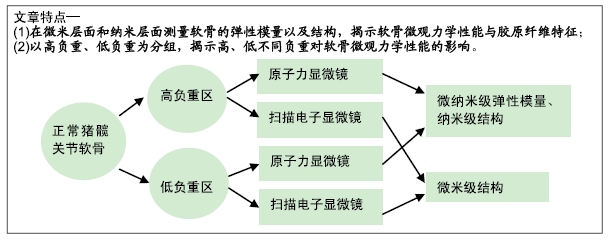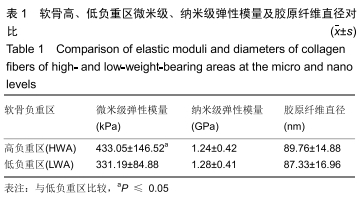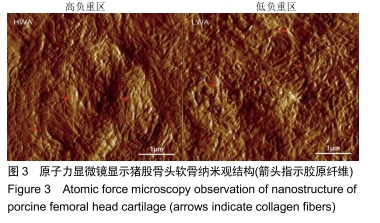[1] RYDELL N. Biomechanics of the hip-joint. Clin Orthop Relat Res. 1973;(92):6-15.
[2] GUILAK F, FERMOR B, KEEFE FJ, et al. The role of biomechanics and inflammation in cartilage injury and repair. Clin Orthop Relat Res. 2004;(423):17-26.
[3] LI J, WANG Q, JIN Z, et al. Experimental validation of a new biphasic model of the contact mechanics of the porcine hip. Proc Inst Mech Eng H. 2014;228(6):547-555.
[4] PAWASKAR SS, GROSLAND NM, INGHAM E,Hemiarthroplasty of hip joint: An experimental validation using porcine acetabulum. J Biomech. 2011;44(8):1536-1542.
[5] BACHTAR F, CHEN X, HISADA T. Finite element contact analysis of the hip joint. Med Biol Eng Comput. 2006;44(8):643-651.
[6] 胡侦明,罗先正.髋关节的生物力学[J].中华骨科杂志,2006,26(7): 498-500.
[7] 王泓,马信龙,张园,等.老年人髋关节软骨负重区和非负重区的拉伸力学性能研究[J].生物医学工程与临床,2009,13(4):335-338.
[8] SANCHEZ-ADAMS J, WILUSZ RE, GUILAK F. Atomic force microscopy reveals regional variations in the micromechanical properties of the pericellular and extracellular matrices of the meniscus. J Orthop Res. 2013;31(8):1218-1225.
[9] AKIZUKI S, MOW VC, MÜLLER F, et al. Tensile properties of human knee joint cartilage: I. Influence of ionic conditions, weight bearing, and fibrillation on the tensile modulus. J Orthop Res. 1986;4(4):379-392.
[10] ATHANASIOU KA, AGARWAL A, MUFFOLETTO A, et al. Biomechanical properties of hip cartilage in experimental animal models. Clin Orthop Relat Res. 1995;(316):254-266.
[11] KARCHNER JP, YOUSEFI F, BITMAN SR, et al. Non-Destructive Spectroscopic Assessment of High and Low Weight Bearing Articular Cartilage Correlates with Mechanical Properties. Cartilage. 2019;10(4):480-490.
[12] KEMPSON GE, SPIVEY CJ, SWANSON SA, et al. Patterns of cartilage stiffness on normal and degenerate human femoral heads. J Biomech. 1971;4(6):597-609.
[13] SWANN AC, SEEDHOM BB. The stiffness of normal articular cartilage and the predominant acting stress levels: implications for the aetiology of osteoarthrosis. Br J Rheumatol. 1993;32(1): 16-25.
[14] DISCHER D, DONG C, FREDBERG JJ, et al. Biomechanics: cell research and applications for the next decade. Ann Biomed Eng. 2009;37(5):847-859.
[15] MUIR H. The chondrocyte, architect of cartilage. Biomechanics, structure, function and molecular biology of cartilage matrix macromolecules. Bioessays. 1995;17(12):1039-1048.
[16] PIZZO AM, KOKINI K, VAUGHN LC, et al. Extracellular matrix (ECM) microstructural composition regulates local cell-ECM biomechanics and fundamental fibroblast behavior: a multidimensional perspective. J Appl Physiol (1985). 2005;98(5): 1909-1921.
[17] FRANZ T, HASLER EM, HAGG R, et al. In situ compressive stiffness, biochemical composition, and structural integrity of articular cartilage of the human knee joint. Osteoarthritis Cartilage. 2001;9(6):582-592.
[18] 李振宇,马洪顺,姜鸿志.关节软骨力学性能实验研究[J].工程与试验, 1989(2):7-9.
[19] ANTONS J, MARASCIO MGM, NOHAVA J, et al. Zone-dependent mechanical properties of human articular cartilage obtained by indentation measurements. J Mater Sci Mater Med. 2018;29(5): 57.
[20] KWOK J, GROGAN S, MECKES B, et al. Atomic force microscopy reveals age-dependent changes in nanomechanical properties of the extracellular matrix of native human menisci: implications for joint degeneration and osteoarthritis. Nanomedicine. 2014;10(8):1777-1785.
[21] CHANGOOR A, NELEA M, MÉTHOT S, et al. Structural characteristics of the collagen network in human normal, degraded and repair articular cartilages observed in polarized light and scanning electron microscopies. Osteoarthritis Cartilage. 2011;19(12):1458-1468.
[22] LIANG T, CHE YJ, CHEN X, et al. Nano and micro biomechanical alterations of annulus fibrosus after in situ immobilization revealed by atomic force microscopy. J Orthop Res. 2019;37(1):232-238.
[23] VILLEGAS DF, DONAHUE TL. Collagen morphology in human meniscal attachments: a SEM study. Connect Tissue Res. 2010; 51(5):327-336.
[24] CHE YJ, GUO JB, LIANG T, et al. Assessment of changes in the micro-nano environment of intervertebral disc degeneration based on Pfirrmann grade. Spine J. 2019;19(7):1242-1253.
[25] CONE SG, WARREN PB, FISHER MB. Rise of the Pigs: Utilization of the Porcine Model to Study Musculoskeletal Biomechanics and Tissue Engineering During Skeletal Growth. Tissue Eng Part C Methods. 2017;23(11):763-780.
[26] FRANKE O, GÖKEN M, MEYERS MA, et al. Dynamic nanoindentation of articular porcine cartilage. Mater Sci Eng C. 2011;31(4):789-795.
[27] IMER R, AKIYAMA T, F DE ROOIJ N, et al. The measurement of biomechanical properties of porcine articular cartilage using atomic force microscopy. Arch Histol Cytol. 2009;72(4-5):251-259.
[28] TAYLOR SD, TSIRIDIS E, INGHAM E, et al. Comparison of human and animal femoral head chondral properties and geometries. Proc Inst Mech Eng H. 2012;226(1):55-62.
[29] QUIRK NP, LOPEZ DE PADILLA C, De La Vega RE, et al. Effects of freeze-thaw on the biomechanical and structural properties of the rat Achilles tendon. J Biomech. 2018;81:52-57.
|





